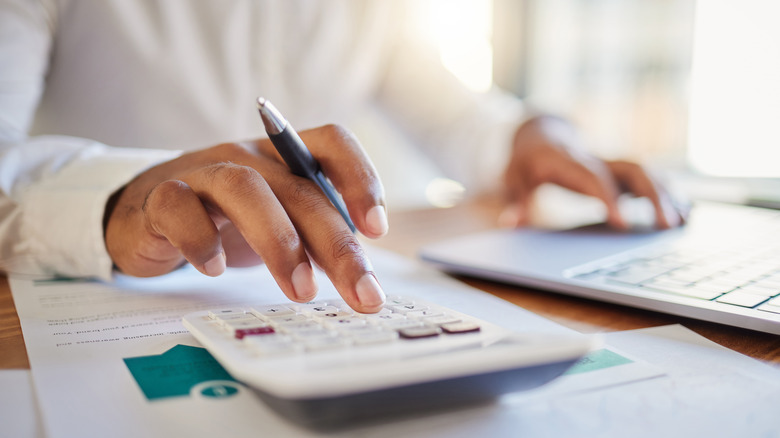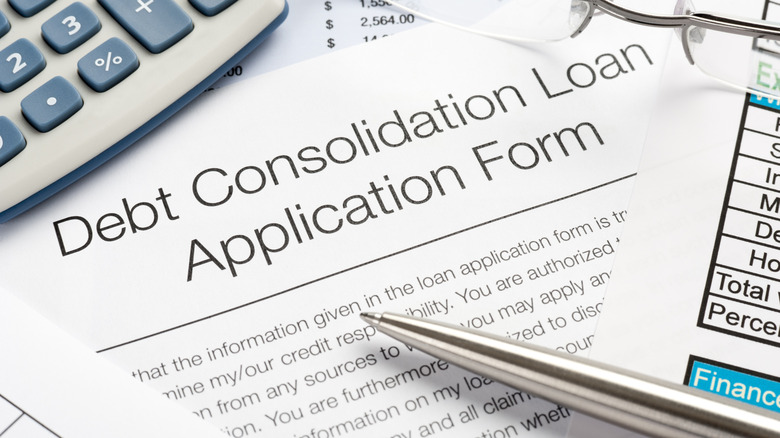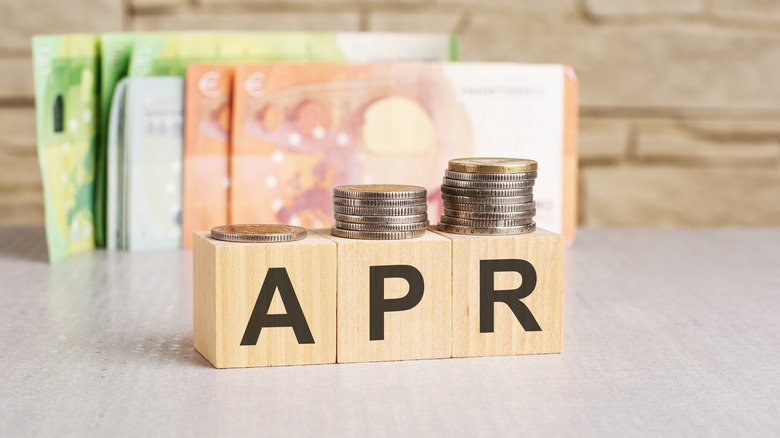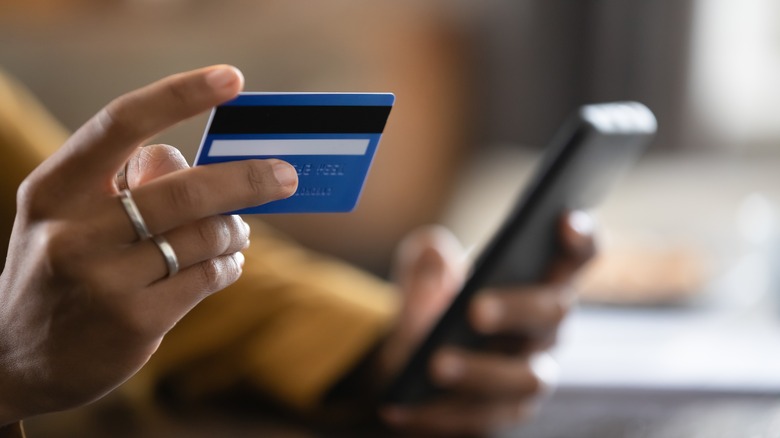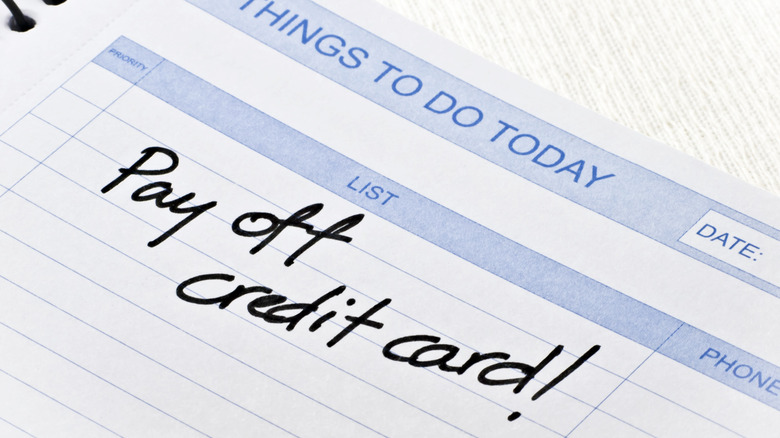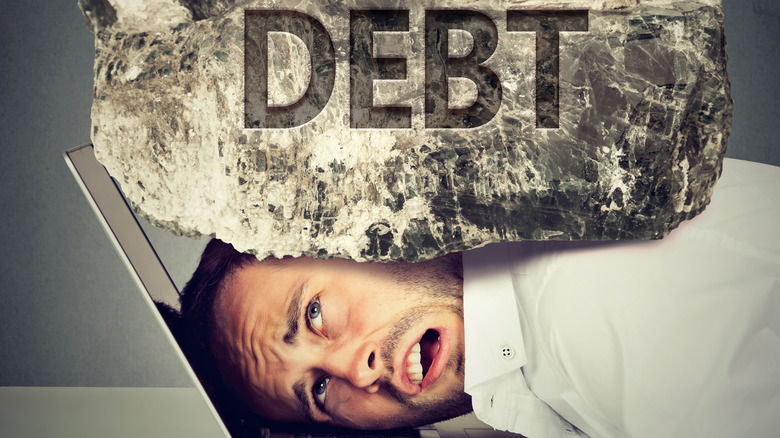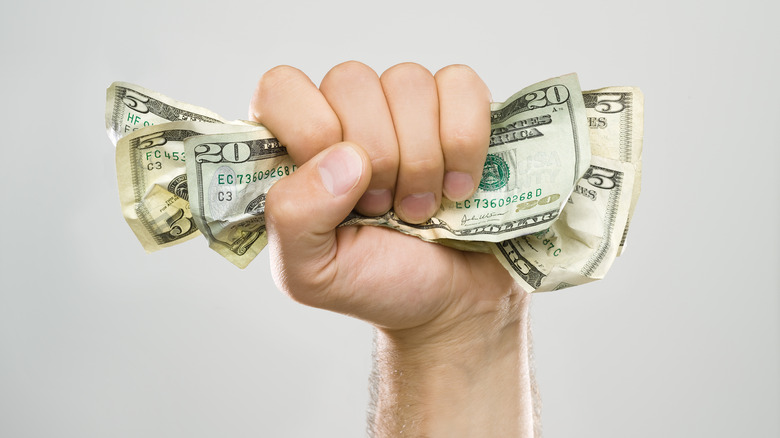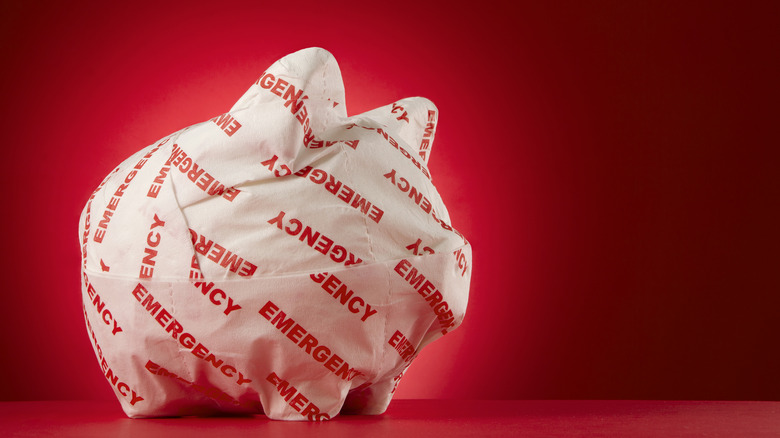17 Genius Tips For Paying Off Your Debt
Debt has become a bit of a dirty word in contemporary society. No one wants to talk about debts, and yet virtually everyone carries some kind of repayment obligation. All told, the average American owes creditors $90,460. This is a comprehensive accounting, though, including student loans, mortgages, and automobile financing — some of the largest debt burdens Americans take on. More pressing debt repayment efforts tend to focus on higher-interest consumer borrowing. Personal loans, credit card balances, and other, similar debts are the most concerning to people looking to reduce their outgoing expenses focused on repayment. Credit cards average an annual interest rate of 21.19%, as of August 2023. This is staggeringly high in comparison to any other kind of typical consumer financing option available to consumers and demands drastic action when used for routine spending.
There are many great ways to start chipping away at debt, and they all begin with a core plan. Whether you're looking to lean in on snowballing your payments or want to consolidate debts to create a more straightforward approach, planning is crucial. These genius money management tips can help you accomplish that big goal and get clear of stress-inducing debts faster than you may have ever expected to be possible.
Start with a rock solid budget
Budgeting is a core value in any money management strategy. If you don't know how much you're spending on a weekly or monthly basis, you'll never find the momentum necessary to get out from under your current debt load. Without a budget, you're particularly vulnerable to increasing the burden, as well. A strict budget can't be overemphasized when it comes to reducing and ultimately eliminating debts. It's the first and most important feature of successful debt repayment.
An additional approach to creating a quality budget lies in a dissection of your previous spending habits. In order to dial in a manageable budget that won't set you up for failure, go back through your spending history and evaluate all of your transactions from the last month — maybe even two months. Adding up the total spent will give you an idea of how much it has been costing you to run your life, weighed against income. After accounting for every outgoing dollar, classify every purchase into categories such as restaurant spending, utilities (such as electricity and trash pickup), other bills (like Netflix or a gym membership) groceries, and savings. This will provide an atomized understanding of where your money has been going, as well as some easy-to-understand cues about how you can develop more beneficial repayment strategies.
Consider the snowball method
One of the most prominent methods to credit card debt reduction is known as the snowball method. Snowballing your payments means focusing on the smallest debt first. If you have five credit cards to pay off, machining minimum payments on four of them and pouring all your extra funding into paying off the one with the smallest balance will result in a rapid payoff for the easiest card to clear. Once that card has been cleared, move on to the account with the next lowest balance. Continue moving through credit cards while making your way up the chain until you've paid off every account.
The reason why the snowball effect is so valuable is because moving on to the second card gives you additional funding to tackle the balance with even greater speed. If your minimum payment on the first card was $100, and you added another $200 to it every month, you suddenly have the ability to pour an additional $300 into the second card when you move your focus onto it. As you continue to eliminate the low-hanging fruit, you'll continually increase the amount of cash you can dedicate to overpaying your bill in an effort to finally kill it off.
Or try out the avalanche approach
The obverse of the snowball approach to credit card payments is called the avalanche method. If you attack debt via this route, you'll see slow, grinding progress, but the overall amount to be repaid is likely smaller. Focusing on your highest-interest credit card first might see you tackling a large bill before moving on to an account with a smaller balance. While you won't be able to fall back on the satisfaction of seeing a zero balance as quickly, clearing the higher interest account first will save you on interest payments over the long term.
Similarly, by reducing a larger payment before the smaller ones, it's likely that when you move onto the next bill, you'll have a much larger volume of funds available to pay down each subsequent account, creating an "avalanche" of sorts when it comes to the speed at which you eliminate each debt. Indeed, many people who approach debt reduction through this method are able to pay off their debts not only with a lighter interest burden, but often also pay off their entire debt burden faster than those who finish through other means.
Utilize a debt consolidation loan
Debt consolidation loans are another high-quality approach to reducing the weight of multiple debts or high-interest credit card repayments. Debt consolidation lending is used to pay off other lending products, eliminating one or more credit accounts and instead moving the monthly payments to a new lender. A personal loan taken out for this purpose may offer a notably lower interest rate than those you're looking to bring under one repayment, lowering the total cost of the debt, as well.
Debt consolidation loans also introduce a structure to your repayments, making for a concrete end date to the loan's lifespan. For anyone who has difficulty visualizing the end of credit card debt because of its open-ended nature, this change can be an immensely welcoming feature that helps keep things in focus. Consolidating your debts may also provide a lower monthly payment than the sum of all the various credit card bills you once paid. The result is either a better cash flow balance or the ability to easily overpay on the debt, reducing it faster and saving on the interest by an increased margin.
Ask your card issuer to lower your APR
Believe it or not, you may have success in reducing your interest rate simply by asking. Credit card users who have shown a lengthy history of on-time payments may be able to reduce the interest rate dictating their card's fiscal math by just picking up the phone and contacting the card issuer. Before you call the number on the back of your card, though, make sure you know the interest rate you're currently paying, and try to get a sense of what a competitor's rate might be if you were to switch.
Pulling out the length of time you've been with the credit card company can also work in your favor. If the card in question is one you've held onto for a decade, for instance, losing your business would be a solid hit to the brand. If you don't get the answer you're looking for, you can always try redialing, too. Calling multiple times will very likely put you in contact with a few different customer service agents, improving your chances of getting what you want. At the end of the day, you may not successfully yield a lower interest rate, but this is a no-risk tool. You lose nothing by asking and stand to improve your financial standing considerably by making the request.
Lean on strategic balance transfer offers
Balance transfers are a true Godsend — if used sparingly. Consumers struggling to pay off multiple credit card balances at once may get bogged down in varying minimum payment demands and a full calendar of due dates. Instead, a balance transfer can move debts from multiple credit cards onto a single account. You might be able to transfer all your credit card and various other debts to a single account or use it to end one or two cards entirely and reduce the number of bills. This will depend on your personal credit limits and the amount of debt you carry. But the ability to load one card with debt from others is an interesting and potentially game-changing feature of the credit landscape.
Consolidating accounts like this means you can focus more of your energy on strategically beneficial repayments. Importantly, many cards offer great terms on balance transfers. You may be able to take advantage of zero-interest terms lasting a year or longer, or very low interest for an even longer period. This allows you to move high-interest debt to a different card, pay only the minimum on the zero-interest balance, and load up overpayments on other debts retaining a high-interest rate. One thing to keep in mind, however, is that opening too many new cards to take advantage of introductory balance transfer offers can tank your credit score and make you vulnerable to the same issues a year or more down the road.
Freeze your credit cards
A potent measure you can take to reduce your debts involves a cold turkey halt to spending on credit accounts. Limiting use is a great idea, but freezing your cards takes them out of use altogether. Taking cards out of your wallet and removing them from your phone's digital wallet app can physically limit your ability to use any given card while you're out and about. Taking this a step further though, logging into your credit card apps allows you to put a complete freeze on them. This will decline any new transaction you might try to make with the card, eliminating the temptation to use it "just this one time."
Bringing new spending on credit cards down to zero makes for a powerful repayment strategy. This is because any money you put toward paying off debts won't go toward servicing new spending. Instead, you can take on a laser focus with regard to existing balances. Your total movement might be slight in the beginning, as a result of excruciating interest additions, but over time you'll begin to see increasingly positive momentum that quickly builds toward total debt elimination.
Approach a nonprofit credit counseling agency
A debt management plan can be a supremely effective way to pay down your existing debts. Working with your creditors directly can open up access to restructured options to make repayments if missing upcoming monthly bills appears increasingly likely. Lenders want to get paid, and if working with you to come up with an alternative payment plan can accomplish this where the regular structure can't, they'll likely be at least somewhat accommodating.
However, if you've spoken with your credit card company and haven't gotten a satisfactory answer on how you might repay your debts, a nonprofit credit counseling agency may be able to help. There are plenty of for-profit companies out there that offer to work on your behalf as well, but the marketplace is sadly rife with scammers who will only leave you in an even more vulnerable financial position after making off with their fees. A nonprofit can serve as a go-between to settle your debt repayment plan directly with lenders. You may even be able to negotiate a partial forgiveness of some of your debt if you're in particularly dire straits.
Come to terms with a more Spartan lifestyle in the short term
No matter what avenues you choose to pursue repayment through, one feature must factor into your thinking early on in the repayment process. Borrowers looking to make serious progress on their debt repayments will have to come to terms with the reality that a sparse lifestyle will need to become the new normal, at least in the short term. While any repayment you make over the minimum requirement will help settle your debt faster, it's futile to think that paying an extra $10 per month on each of your cards will make much of a difference with any sort of haste.
Instead, cut out some of the more extravagant expenses in your lifestyle. Instead of eating dinner out at a restaurant once a week, make yourself a dinner on a shoestring budget that night. Rather than hitting the town every Saturday, only go out for drinks once per month — perhaps even forego social gatherings altogether for a month or two at a time. Getting used to being a bit of a spendthrift will help you alter your spending habits over the long term, potentially imbuing you with better money management habits for good. But in the short term, this new normal will give you a noticeable addition to the amount of money you're spending on repayments. The more you pay off the faster your debt will reduce, so tightening the belt a bit will make an outsized difference.
Cancel one or more of your memberships in the short term
In the same breath, it's a good idea to think about the memberships you maintain. The average American spends $219 monthly on subscriptions, two and a half times what the typical spender thinks they're putting toward these services! Cutting off a few subscriptions (or reducing your spend by two and a half times) can make a big difference in the available cash you have on hand for other essentials and for debt repayment.
Cutting the cord on memberships like this can also free up valuable time. If you put your Netflix subscription on ice, for instance, you might start going to bed earlier or get out for a walk in the evenings instead of binging TV. These lifestyle changes can make for better overall mental health that translates into other improvements across your daily routine. You may ultimately choose not to return to the service later down the line in favor of some new hobby or activity. At a bare minimum, canceling a few subscriptions will give you a bit of extra cash to continue prioritizing debts in the short term.
Pay your card in two installments instead of one
A highly underrated approach to credit card management involves breaking repayments into multiple installments. For most, paying the minimum — or some additional sum on top of the requirement — is done in a single lump sum transfer. Near the due date, most people sign onto their credit card app and schedule a payment to cover their bill. However, breaking your payment into two chunks and spacing them out evenly across the month (i.e., paying half the bill every two weeks) can create some unique financial benefits.
First of all, if you're dealing with revolving credit balances that are subject to additional interest charges, the two payments will shave off an extra little bit from your average daily balance. This results in a lower interest-bearing balance across the month and a bit of savings when the bill is generated. If you do this every month, and with every account you owe money on, you may save yourself a noticeable amount of interest over time. Secondly, splitting payments like this throughout the year results in an extra full monthly payment (52 weeks divided by four is 13, not 12). The added payment can create a significant benefit as you work your way through existing debts.
Sign up for a debt repayment app
Debt repayment apps can make the hazy circumstances surrounding the creation of a debt reduction plan clear. Undebt.it and Tally are great options in this regard. Undebt.it is a free payoff plan calculator that helps create a focused plan of attack to reduce and ultimately eliminate debt. Through one of seven accelerated payoff strategies, including the snowball and avalanche methods as well as a few more technical and calculated approaches, you can work through repayment strategies in order to find the best approach for your needs. The calculator is a great resource for anyone getting serious about their credit card balances or other debts.
Tally, on the other hand, operates as a line of credit that pays your credit cards for you. The tool typically offers this helping hand at a lower interest rate than your card issuers charge, making for a sizeable amount of savings on interest payments over the long term. In fact, Tally notes that it can save users up to $4,300 over the course of seven years of repayment use. Every month, the service pays your cards for you, taking the stress of meeting due dates off your shoulders. Then you pay one bill to Tally. These tools can take some of the guesswork out of the debt reduction process and give you a bit of breathing room; they're worth seriously considering as a result.
Delete saved credit card information at online retailers
In much the same way that removing a card from your wallet helps naturally provide a bit of extra impulse control, other avenues can offer the same kind of result. One important step you can take is the removal of saved credit card information at online retailers. By deleting your saved payment data, you'll have to fish out your card every time you want to make a purchase online instead of simply relying on the single push of a button to select your payment method. This creates an added step when making any purchase at a digital storefront, leading to just one more natural barrier between wanting to buy something and actually parting with your money.
For many, leaving hurdles in the way of spending money can make for a bit of extra time to think about whether or not the purchase is worth it or necessary. This is particularly valuable when considering nonessential spending. Anything you can do to stem the practice of overspending on things you don't need is valuable, and this added step when buying goods online can actually go a long way to helping you focus your efforts on repayment while limiting the amount you're spending, with both debit and credit cards. Maintaining a balance that works in your favor is crucial, and minimizing spending is the first step toward that goal.
Think about listing unused items for sale
Selling unneeded stuff around the house can act as a potent boost in your efforts to repay credit cards or other kinds of debt, as well. Many people hold onto things they no longer use for far too long or keep collectibles in their attic to sell them at some point in the future. If you're struggling to manage your debts, selling these kinds of items can make for a gigantic swing in the right direction. Pokémon cards, a collection of Beanie Babies, sports memorabilia, or furniture that you no longer need can make for a great boost to your payoff plans.
A lump sum payment to your credit card can drastically reduce both the interest you're paying each month and the minimum monthly payment. This figure is typically calculated as a small percentage of your balance, sometimes with interest or other calculations factored in as well. If you're able to reduce your minimum contribution by $100, for instance, you'll gain the resulting $100 as money that can be used more efficiently toward payments on the principal, or another account that fits with your repayment strategy more effectively.
Use your tax refund solely for debt reduction purposes
One tool that many people underestimate is their tax refund. In 2022 the average refund was $2,753, a sizeable cash infusion that can make a solid dent in any repayment plans. Mark Cuban and many other wealthy people suggest using tax refund dollars frugally. Instead of splurging with the newly returned capital, use it to pay off a credit card or make a large contribution to your retirement account.
If you're struggling with credit card bills, putting the entire sum toward one of your cards can make for a dramatically improved situation. Reducing the total amount owed by thousands of dollars can instantly boost your credit score, and it will slash the amount of added interest that the account accrues every month. You may even be able to eliminate one bill entirely with the help of your tax refund, freeing up funds that can be redirected toward another account via the snowball or avalanche methods outlined above.
Don't discount the value of an emergency savings fund
It's not a direct payoff strategy, but the value of an emergency fund cannot be overstated. Emergency savings create an essential buffer between routine finances and the inevitable spending emergency that can come out of the blue to wreak havoc on your finances. This is an invaluable piece of the puzzle when creating good money management habits.
Experts note that emergencies are increasingly likely to be paid for via credit card, which creates an even more pressing financial vulnerability. For those working hard to reduce debt, the need to fall back on a credit card to buy a new water heater or take a child to the hospital after an injury can undo all the great progress already made. Building up your emergency savings fund allows you to continue focusing your attention on debt reduction, without the threat of bad luck ruining your progress and placing you back near the starting line.
Pursue a side hustle to create additional repayment power
Last but not least, anyone looking to seriously demolish their debts should consider taking up a side hustle. Any new work activity that brings in a bit of extra cash can make for a huge boost in repayments and confidence in ultimately accomplishing that distant goal. A side hustle doesn't have to be a second job in the evenings. It's possible to take up a bit of part-time work in your local community or work as an Uber or Lyft driver, or focus on monetizing one of your hobbies.
Building a skill you already possess into a second stream of income is a great way to get paid to do what you love. If you're an avid golfer, consider writing a golf blog or starting a YouTube channel to document your playing journey. Musicians can write tunes or ambient background music and upload their productions to platforms that pay artists for their contributions. No matter what you're good at or enjoy doing, there's likely a way to monetize your hobby to create a bit of extra income that can go directly toward paying off your bills. Side hustles take willpower and sacrifice. Instead of enjoying some downtime after your daily routine winds down, you'll have to pick yourself back up again to start at your second income creator. This is tough to maintain, but in the short to medium term, it can be a powerful driver behind an ambitious payoff goal.

